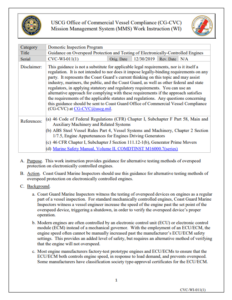The US Office of Commercial Vessel Compliance released a work instruction to provide guidance to US Coast Guard marine inspectors for alternative testing methods of overspeed protection on electronically controlled engines.
Modern engines are often controlled by an electronic control unit or electronic control module instead of a mechanical governor. With the employment of an ECU/ECM, the engine speed often cannot be manually increased past the manufacturer’s ECU/ECM safety settings. This provides an extra level of safety, but requires an alternative method of verifying that the engine will not overspeed.
[smlsubform prepend=”GET THE SAFETY4SEA IN YOUR INBOX!” showname=false emailtxt=”” emailholder=”Enter your email address” showsubmit=true submittxt=”Submit” jsthanks=false thankyou=”Thank you for subscribing to our mailing list”]
Field verification of overspeed protection is necessary. However, intentionally subjecting engines with a ECU/ECM to 115% of rated speed creates unnecessary risk to the marine inspectors and equipment.
The owner or operator may safely demonstrate the overspeed protection by changing the overspeed set point on the ECU/ECM in order to test the failsafe below 100% of rated speed.
USCG will continue to verify mechanical engine overspeed device operation in accordance with current regulations. Verification of the electronic overspeed protection device should be conducted not less than once every five years. This test should be conducted in accordance with the manufacturer’s test procedures.
See more information in the following report































































